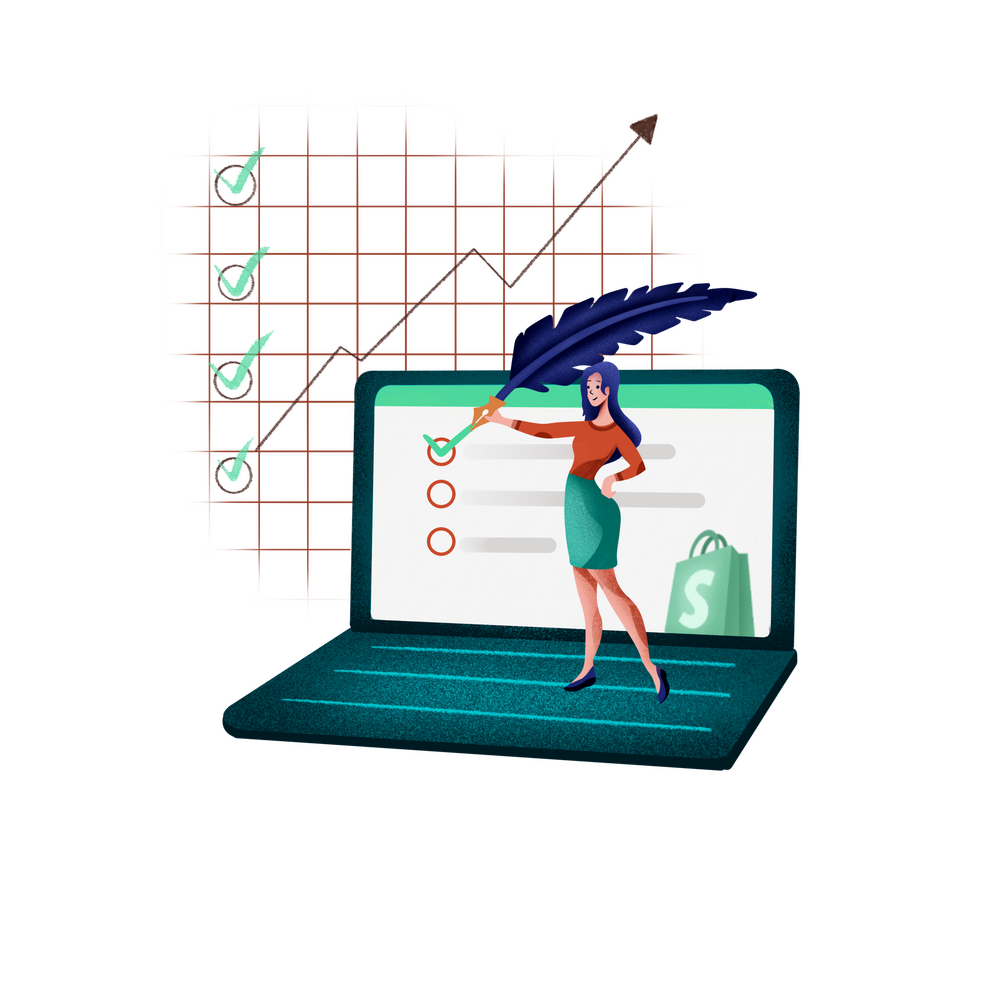When you launch an online store, you have every reason to be proud.
You’ve made a lot of decisions! You’ve (hopefully) developed a compelling, cohesive brand identity, chosen a kickass theme, and put in some work to understand your customer. Yay!
Take a deep breath and appreciate how far you’ve come, because there’s still work to be done.
Getting your Shopify store set up is just half the battle. Now you have to make sure that people actually see it. Let’s start with the Almighty Search Engine, shall we?
Since 68% of online experiences begin with a search engine, it makes sense that you’d want it to be easy as hell for people to find your store via channels like Google or Bing. However, considering the literal billions of search results generated by Google alone in a single day, that can seem like a monumental task. Enter: SEO (Search Engine Optimization). Investing some time and energy in SEO might not always have immediate payoffs, but if your goal is steady traffic in the long run, it’s worth it.
Not sure where to start? Here’s our ultimate Shopify SEO guide, which will teach you how to optimize your store, improve its search engine rankings, and start pulling in those eyeballs.
What is SEO?
SEO is the process of optimizing your website so that a search engine can easily:
- Crawl it and understand its contents
- Assess its value
- Present relevant pages to users searching the web for that kind of content
Users searching for something online head to Google (yes, Bing is technically a thing with ~7% market share--but Google claims 87%) and type in their query. The Google bots determine which web pages are most relevant, and then attempts to show these pages in order of importance. (“Importance” meaning “most relevant” or “best optimized.”)
(Note that the results allll the way at the top are going to be paid results, and not a result of organic SEO.)
Websites that are optimized according to the factors a search engine looks at will rank higher and get more traffic. These factors include:
- The number and quality of other websites linking to your site
- Whether users stay on your website once they land there (bounce rate)
- Age of your domain name
- Content structure and architecture
- and more
So, the best way to get traffic to your Shopify store is to take care of as many SEO aspects as possible, starting with the most basic requirements. Here’s your checklist!
Shopify SEO
SEO is a long-term investment. In other words, it’s a marathon, not a sprint. That said, you can get some small wins in the interim by implementing the following best practices in your Shopify store.
Shopify stores have many built-in SEO features such as:
- Adding canonical tags to pages to avoid duplication issues
- Robots.txt files and sitemap.xml
- Generating title tags with your store name
These features are great, but there are still important aspects you can’t control with Shopify’s native features, and you’ll have to tackle them yourself (or with the help of an app like Plug in SEO). These technical optimizations smooth the way for heavier-impact SEO strategies and can be broken up into two main areas: Technical & Admin, and Content.
Technical & Admin
These are the -- ahem -- rather boring nuts and bolts that should be checked off the list before moving on to meatier strategies. They are the foundation for success. The good news is that once you get them handled, there isn’t much regular maintenance to do!
Get a Custom Domain Name
This is a no-brainer, right? Beyond just SEO, it’s Business 101 to have your own domain name. For bonus points, buy domain names that are similar to yours or possible variations that include keywords users might use when searching for your type of products.
For example, if your primary domain is hatsfordogs.com, you might want to grab hatfordog.com, hatsfordog.com, dogswithhats.com, and so on. These “extra” domains can simply be redirected to your primary one.
To snag a domain name directly through Shopify, log in to your Shopify Admin dashboard and go to Sales Channels > Online Store > Domains. Then click Buy New Domain and complete the remaining process. If you’ve purchased your domain name from another provider like GoDaddy or NameCheap, just click the “Connect existing domain” option and take it from there.
Submit Your Sitemap to Google Search Console
Google Search Console is a set of Google tools provided to website owners. They help you communicate with Google about your site and check if it’s being successfully indexed by the search engine.
To get started, create a Google Search Console account and submit your Shopify store’s sitemap.
A sitemap is a file that tells search engines about the structure and pages of your website.
The good news is that a Shopify store automatically generates its own sitemap, which can be accessed through sitename.com/sitemap.xml. All you need to do is point to this URL during the sitemap submission process.
Pro Tip: You should check back within a few days of submission to be sure there aren’t any crawl errors.
Submit Sitemap to Bing Webmaster Tools
While Google is the undisputed champion of search engines, Bing is a relatively popular alternative, so you may as well make sure your store catches its eye.
Just as Google provides you with Google Search Console, Bing offers Bing Webmaster Tools, which lets you add a sitemap to the Bing crawler.
Create Listings in Business Directories
This tactic has been exploited a lot over the years--so much, in fact, that most business listing websites have lost their relevance and importance in the eyes of search engines. The days of submitting your website to hundreds of article directories, business lists, and bookmarking sites are long gone.
Having said that, there are still a handful of high-quality business directories on which it’s worthwhile to submit a listing:
- Yellow Pages
- Google My Business
- Better Business Bureau
- Apple Maps
- Bing Business
- Yelp
- Foursquare
- Angie’s List
Submitting and managing your business listing on these websites doesn’t take much time and offers value, but managing is key here. If you set up a business listing and then never touch it again--especially if customers and would-be customers are attempting to engage with you there--it can actually have a reverse effect, seeding doubt about your legitimacy or success as a business.
Optimize Your Permalinks
A permalink or URL is the web address associated with each page of your website. This is what shows up in a web browser when someone visits a page on your online store.
Optimizing your URL may seem like an insignificant task, but when it comes to SEO, every little thing matters. Your URLs are visible to both search engines and visitors who use them to make sense of what your page is about.
Here are some best practices to keep in mind:
Make sure URLs are readable.
✅ https://yoursite.com/blue-sports-shoes
⛔️ https://yoursite.com/main.php?33434=g34=
Use hyphens instead of underscores.
✅ https://yoursite.com/velvet-dress
⛔️ https://yoursite.com/velvet_dress
Include target keywords without being ~ extra ~.
✅ https://yoursite.com/mens-leather-travel-bag
⛔️ https://yoursite.com/polkdot-bag-leather-black-for-men-travel
Your goal is to keep your URLs as short and human-friendly as possible, while embedding your target keywords (more on that later).
Redirect Outdated/Broken Links
When a page on your eCommerce store becomes inactive (like when you stop selling a product and remove it from your site, for example) and a customer clicks a link to that page, it’ll return a 404 error--which is super annoying to customers and very bad for SEO.
(This is just an example we pulled by typing takoagency.com/page-page. We are like 404-sniffing truffle pigs, tyvm.)
To avoid this issue, you can redirect the broken links to another relevant and active page. This will enhance user experience and keep them on your site, as it gives users a new destination instead of a dead end.
Creating a URL redirect in Shopify is easy. Go to Admin > Online Store > Navigation and click View URL Redirects.
On the next page, click the Create URL Redirect button.
Create your redirect by entering the outdated URL in the first bar and the new destination URL in the second bar. Click the Save button, and you’re done!
Check for Speed and Responsiveness
52.2% of all website traffic worldwide comes from mobile phones, so a website that loads quickly (i.e. less than 3 seconds per page) and renders well on both mobile and desktop devices is another important factor that impacts your search engine rankings.
The good news is most high quality Shopify themes are already mobile-friendly. That said, it doesn’t hurt to check using a tool such as Google’s Mobile-Friendly Test--especially if you end up doing custom work on the theme or choose to have a new one designed from the ground up.
Same goes for speed. Shopify does a number of things behind the scenes to make sure your eCommerce website loads speedily--but you also have a role to play in terms of the content you add to your pages.
A few things that affect load speed are:
- Oversized visual content. Definitely compress any and all photos or video content that appears on your site. We love the Squoosh app for easy-peasy compression and resizing. Generally speaking you want to aim for the lowest file size you can for each image, balancing image size and quality with the resulting file size. A general rule of thumb is no image should be over 500KB.
- Clunky code. “Minifying” is the process of removing unnecessary formatting, unused code, and comments, and it can have a substantial positive impact on your load speeds.
- Excessive redirects. Yes, we said earlier that broken or unavailable pages should redirect, but it’s important to keep the need for redirects to a minimum. Every time a customer clicks a link that requires a redirect, they have to wait for a second (or third or fourth) page to render, which increases the perceived load time of a page.
- Apps on apps on apps. Every app you install on your store plays a role in page load speed, so take a few minutes to delete apps you’re no longer using and make sure that any code they’ve injected onto your live theme has been scrubbed. (Deleting the app from your admin dashboard does not automatically remove the code from your site.)
Some apps will allow you or your development team to make changes on a code level to force widgets to load more quickly, but if you don’t have a bit of development experience, it’s best not to attempt this alone.
This is by no means an exhaustive list. Try running your website through a tool like PageSpeed Insights to get recommendations on what actions you can take to improve your Shopify store’s performance. The reports can be a bit technical, so if you’re not sure what you’re looking at, connect with us for some help.
Content
Research and Leverage the Right Keywords
Three-quarters of SEOs say content is the most important factor for an SEO-friendly website. “Content” is literally anything on your site--text, images, everything--and there are myriad ways to optimize it.
One of the heaviest hitting items in the SEO-for-content game, though, is the keyword. This will require some research, but once you determine which words and phrases people are using in search engines to find the types of products you sell, you can use them in your headers, subheaders, product descriptions, and any other copy on your Shopify site.
The benefits of this are twofold:
- Your customers see that you speak their language (read: can fulfill their needs)
- You show search engines that your website has what searchers are looking for
There are hundreds of keyword research tools you can use, but some of the most popular ones include Moz’s Keyword Explorer and Ahrefs.
No matter which tool you use, there will almost certainly be some measure of trial and error. Play around with different phrases to find the keywords that have high search volume and make the most sense for your business. Check in every 3 months to see how your keywords are performing, and make tweaks as necessary.
Ensure Internal Linking for Maximum Content Organization
Internal linking is among the cornerstones of proper SEO. It helps search engines recognize your topical relevance and organize your content.
Internal linking refers to embedding links in each page of your website to other relevant pages of your website. You should do this only as long as the links can be embedded naturally. They should not come across as forced.
Here are some of the best ways to sprinkle internal links throughout your website:
- Related Products: Showcase related products on each of your product pages. This will help search engines make connections between products and index the items accordingly.
- Featured Items: Display featured products on your front page and collection pages.
- Start Blogging: Writing value-driven articles on topics related to your business gives you the opportunity to link to other pages of your online store. (Plus, it’s just a really good idea in general.)
~
As searcher behavior continues to evolve, so do search engines and their algorithms -- but the one thing that has remained the same is the focus on value. Searchers want relevant, high quality content, and search engines strive to provide it.
With that in mind, the only evergreen SEO strategy is to provide searchers with what they want. So long as you keep this simple principle in mind, search engines will reward you with more exposure.
However, a warning: try to trick search engines with shady tactics and you’ll soon see your traffic dwindle. The days of keyword stuffing are long gone. Not only is this archaic strategy ineffective, but Google will actually penalize you for trying to “game the system.”
Ultimately, you want to convince search engines that you can provide a great experience for potential customers, and then deliver on that promise with your on-site user experience.
Still unsure of how to go about setting up your store for SEO success? We do that.

















